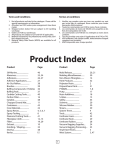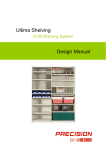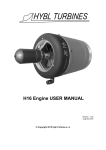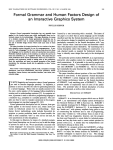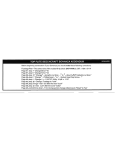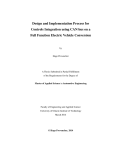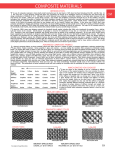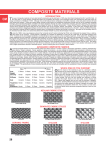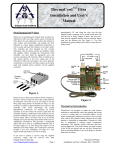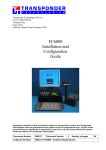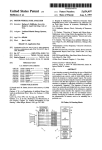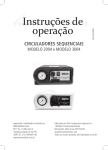Download Newsletter of the Jet Pilot`s Organization
Transcript
Newsletter of the Jet Pilot’s Organization Contrails Winter 2012 Shazam Kianpour’s Fei Bao MB-339 launches itself into the clear blue Colorado skies. Greg Moore photo. Volume 24, Issue 1 Contrails 2 President’s Report Keith Sievers - Since the temporary funding bill for the FAA expires on February 17, Rich expects the bill to reach a vote early next week so that it gets to the President by February 7, at least 10 days before the expiration of the temporary funding. FAA Update By the time this issue hits print, events will hopefully have played out as outlined below. On January 31, the conference committee that was working on the blending of the House and Senate versions of the FAA reauthorization bill finally completed their work and compromise legislation has been sent back to the House and the Senate for a vote. This bill includes wording exempting model aviation from FAA regulation. I talked to Rich Hanson, the AMA leader who has been working this issue, at length and here is direct information from him. - The bill exempts model aviation from FAA regulation, as long as activities are conducted in accordance with the rules of a community-based safety organization. - The bill describes what constitutes a "community-based safety organization." Without running through the entire list, the AMA is the only organization that would qualify at this point in time. - This, however, does not mean that the FAA cannot pass restrictions prohibiting or controlling model operations in the interest of public safety. So, for example, they could still prohibit or control model aviation in the vicinity of airports. Once the bill is passed, the AMA will continue to work with the FAA on a memorandum of understanding to outline these operational limitations. In my view, the AMA has done a tremendous job in protecting the interests of their membership while working diligently and professionally with the FAA and Congress. I would like to single out Dave Mathewson and Rich Hanson in particular, whose leadership and support of the jet community throughout this process have been genuine and consistent. We were fortunate to have these gentlemen in key roles throughout this process. Merchandise JPO merchandise is now available for order through the JPO website, www.jetpilots.org. Please visit and support the organization through a shirt or hat purchase! We will also be offering T-shirts in the near future for $5 through the website and at some jet events throughout the year. My thanks to Bob Brusa, our Northwest Region VP for his work on this project. Go Green While speaking of T-shirts, we will also offer a free T-shirt to those members who voluntarily elect to Go Green by electing to receive their issue of Contrails electronically. Not only will it contribute to the elimination of paper, but the issue will be available in full color electronically, something we can't afford to do in paper form. To make this election, please drop me a note at pilot114@ aol.com. Thanks to all members and fly safe .... Keith - Because there is still work to do with the FAA, the AMA is asking the membership to take a low profile right now and let things play out. - The conference committee bill cannot be changed in the House or the Senate. They can approve it or reject it as is. Rich's expectation is that it will pass, as this legislation is the culmination of five years of effort to finalize FAA funding, and he believes the compromise bill adequately addresses the issues that have stalled the legislation to this point. - The President could veto the bill, but there is no indication that this will happen. He could also set the bill aside and do nothing, and it would become law after 10 days, if he does not outright sign the legislation. The Russian teams Mig-27s at the JWM. 3 Contrails Vice President’s Report Al Watson damage. I bring this up because, on our expensive models, it is good practice to have the retract system on its own dedicated air supply. Put all the other sub-systems, brakes, opening canopy, and so on, on a separate system. The Christmas and New Year holidays are over and I hope that Santa was good to all. The weather here in the Pacific Northwest is cold and wet, so there will be no turbine flying for the next few months. That means it is a good time to complete those half-finished projects and do maintenance on your existing models, so that everything will be ready to go when the season starts. Over the years one of the things that I have noticed is that jet modelers seem to have more than their fair share of problems with the pneumatic systems on their models (retracts, brakes, and so on). Many of these problems could be avoided if the builder used quality components and tested as many of the system parts as possible prior their being installed and buried in the airplane. A quality system should hold pressure for a long time with minimal leakage. My airplanes can sit in the shop for weeks, and, in most cases months, with little, if any, loss in air pressure. All of our models require wheel brakes and most have retractable landing gear (and sometimes doors) of varying configurations. Additionally, some of the more sophisticated airplanes have speed brakes and opening canopies. When it comes to choosing the system for operating your retracts, doors, brakes, opening canopies, etc., we have a number of options. There are three basic system types: pneumatic, hydraulic and electric. Almost all of our models use pneumatic systems, though a few are hydraulic and, although electric retracts have been around for many years, their application thus far has only been for small light-weight models. Several manufacturers are moving into high-end electric systems that will be applicable to our heavy turbine-powered airplanes and it will be interesting to see how these advances work out. I will limit my discussion to pneumatic systems since that is what most of us are using. The first decision that must be made is how is the system going to be configured, and that should be based on what features the aircraft has (brakes, retracts, gear doors, speed brake, opening canopy). The one system that must work all the time is the retracts. Being forced to land the airplane with the retracts half down, or fully up, will most likely result in a lot of damage and could even "FOD" the turbine if you did not get it shut off before touchdown. Failure of the other sub-systems (brakes and opening canopy) will most likely not result in a lot of Moving to the specifics of the various sub-systems there are a number of decisions to be made about the devices to be used to achieve the functions required. Let's look at these one by one. RETRACTS If the retract system is simple - one where there are no doors to open or close, or one where the doors are attached to the struts, then all that is required is a retract valve. I like to use the Robart variable rate valve (VR 167), which allows you to control the up and down speed of the retracts. I like to set the system up so that the "down" speed is faster that the "up" speed since in the unfortunate event of a "flame out" you might be in a position where it would be best to keep the gear retracted as long as possible and a faster "down" speed will help in this situation. If your retracts are of the "air up-spring down" variety, then I use Robart valve VR 186. I think the case should be made for not using "spring down" retracts on our expensive jet models. The spring in the retract unit must be strong enough to drop the gear and lock the unit and, if the gear retracts forward, do this against the on-rushing air pressure. On the "gear up" cycle, the system air pressure must be high enough to raise and lock the retract in addition to compressing the "down" spring. Personally, I feel this whole operation is a delicate balancing act and is not easy to achieve with high reliability. Moving on to a system that utilizes gear doors of various configurations - all doors open, gear deploys, doors stay open, or a more complex situation where all doors open, gear deploys and some doors close, while others stay open, you have a choice of a number of sequencers that can accomplish this task, some electronic and some pneumatic. First decide whether you want to go electronic or pneumatic and then look at what is available within that group. Talk with other jet pilots, or ask questions on RCUniverse. I have been using pneumatic sequencers by Ultra Precision (Ontario, Canada) and have been extremely satisfied with their products and support. WHEEL BRAKES Brakes are much like retracts in that there are different types and systems. Most are pneumatic, and most use the expanding O-ring concept, though there are a few that are disk-type systems. I do remember seeing one that was hydraulic, and it had a "disc" system at the wheels. The expanding O-ring types are very reliable and can last a long time, I have never needed to replace an O-ring. Contrails 4 Vice President’s Report (cont’d) To activate the brakes, a brake valve is required and, like retracts, there are pneumatic valves and electronic ones. Once again, I like the pneumatic valves and have extensively used the BVM Smoothstop and the Ultra Precision UP-6. Both of these valves give smooth proportional braking and lose very little air. They can be left in any position in the stroke without losing air - this is important to me because I like to pre-set the brakes sometime during the flight and not all electronic brake valves will do this without losing a lot of air, and possibly rendering the brakes inoperable. OPENING CANOPY Opening canopies are "cool" things to have on a scale jet, and my Yellow F-15 has an opening canopy which is pneumatically operated using a UP-3 valve to operate both the locks and the canopy itself. You can see all the details of this design in my column in Fall 2009 issue of Contrails. SPEED BRAKES Speed brakes are generally operated one of two ways pneumatically or with a servo. Before you go with a servoactuated system it is important to make sure that the servo selected can do the job with an adequate margin before stalling and drawing high current. A safer solution is to use a pneumatic cylinder which can be operated by a simple Robart retract valve. USING QUALITY HARDWARE Most of the hardware that we use is of fairly high quality, however, most of the leaks that I have found were in cheap items like plastic tees and elbows. The biggest problem seems to be with the barbs on these products which are there to provide a seal within the line. I use only brass tees and elbows that have very well defined barbs - and I like the ones from MEM-CO . MEM-CO manufactures a huge line of brass fittings of all shapes and sizes, and you can contact them at www.mem-co.com. The best air line I have found is made by FREELIN-WADE (polyurethane part # 1J-157 which is .125 in o.d. and .063 in i.d.) which comes in many colors and sells for approximately $7.00 for a 50 ft. roll. You can find them online at: www.freelin-wade.com. The MEMCO tees that fit this air line sell for approximately $1.00 each. If these companies do not sell retail to your state, then you can ask who sells their products in your area. I am lucky to have a retailer who carries these products and they are located only a few miles from my home. Al Watson get installed in the airplane. There is nothing more discouraging than to get everything installed and then discover that you are losing air - and finding which is the offending component is not always easy. Take a look at the Robart website (www.robart.com), click on the "support" tab and look at the "Air Leak Troubleshooting Guide." This guide will give you detailed instructions on how to test many of the components of our pneumatic systems - tanks, retract cylinders and valves. Do not forget to test every tee-fitting by putting a short piece of tubing over two of the barbs, use the pump to pressurize the part and check under water. Here are a few of questions that I frequently get: 1) Do I need to add lockwire to all of these tubing/nipple joints? - No. I have never used lockwire and I have never had a line come off of a fitting, but remember that I use brass fittings with sharp barbs. 2) How do I get the tubing off the fitting? - Under no circumstances should you use an Exacto knife. This will score the fitting, damage the barb and cause a leak. Cut the tubing an inch or so back from the fitting, hold a lit match under the tubing/fitting for one or two seconds - this will soften the tubing so that it can be easily pulled off with a pair of pliers. Too much heat will melt the tubing and leave a mess. 3) Why do my retracts not deploy and retract at the same time? - Let's talk about the two mains. You have an "up" line and a "down" line coming from the sequencer. These lines each terminate in a tee fitting and you then have a line going to each of the main retract units. The lines from the tee to the right and left retracts must be the same length otherwise the retracts will not operate in unison due to minor pressure differences. The "up" lines and "down" lines can be different lengths. The nose gear will generally respond quicker than the mains because it is usually located much closer to the sequencer. There is another reason that the retracts will not act in unison - one that we can do nothing about. Each retract unit has a "break away" load that must be overcome before the piston will move in the cylinder and the "break away" load is dependent upon the tolerance of the various parts in the system. Minor tolerance differences in the retracts will cause them to start operation at slightly different times. Happy Landings, TESTING COMPONENTS I cannot over emphasize the importance of testing as many of the system components as possible BEFORE they Al 5 Contrails Upcoming Events Top Gun: April 27-May 1, 2012 Lakeland-Linder Airport, Lakeland, FL CD: Frank Tiano 863-607-6611 www.franktiano.com Mississippi Afterburner Jet Rally: May 3-5, 2012 John Bell Williams Airport Raymond, MS (suburb of Jackson, MS) www.mississippijets.com Dixie Jet Rally: May May 3-6, 2012 St. George, UT Central Texas Jet Rally: May 17-19, 2012 ARCA Club Field, Austin, TX CD: Dan Massey www.austinrc.org "First in Flight" Jet Rally: May 24-27, 2012 Wilson Industrial Air Park in Wilson, NC CD Larry Lewis 919-231-4983 [email protected] Mount Pleasant, TX Jet Rally: June 14-16, 2012 Mt. Pleasant, TX www.mtpleasantrc.com OC-Turbo Fest-Early Summer Edition: June 22-24, 2012 Titusville Airport; Titusville, PA [email protected] Thunder Over the Valley: June 22-24, 2012 Woodland, CA www.wdarc.org Big Apple Jet Rally: June 23- 24, 2012 Brooklyn, New York Jets over the Heartland: June 28-30, 2012 Winamac, IN http://winamacaeromodelers.com/whats_new.html Jets over Kentucky: July 6-15,2012 www.visitlebanonky.com/events/kyjets.htm Capitol Jets : July 13-15, 2012 South Albany Airport, S. Albany, NY www.capitoljets.com Liberty Bell Jet Rally: August 2-5, 2012 Donegal Springs Airpark, Marietta, PA. www.libertybelljetrally.com Michigan Jets Annual Charity Event : August 9-12, 2012 Grosse Ile, MI www.michiganjets.com New England Jet Rally: August 17-19, 2012 Gardner, MA www.wachusettbarnstormers.org Minnesota Jet Rally: August 23-26, 2012 Rushford, MN CD: Dave Dennison [email protected] Jets over Whidbey: August 24-26, 2012 Whidbey Island, WA www.wircsrc.com. CDs: Al Watson and Bob Brusa Nighthawks Jet Rally: August 24-26, 2012 North Jackson, Ohio (Youngstown area) http://nighthawksrc.com/Home_Page.html 30th Greater Southwest Jet Rally: September 6-8, 2012 HOTMAC club field; Waco, TX. www.hotmacrc.org [email protected] Route 66 Jets: September 6-9, 2012 Litchfield, Illinois Municipal Airport CDs: Roger Shipley and Jim Allen www.route66jets.com Treasurer’s Report Beginning Balance as of October 31, 2011 $6,200.66 Income Dues - Cash/Check $925.00 Dues - PayPal $3,066.91 Total Income $3,991.91 Expenses Postage/Stamps $79.20 Office Supplies $22.32 JPO Apparel $40.50 Conference Call $164.31 Contrails $1,702.16 Total Expenses $2,008.49 Ending Balance as of January 31, 2012 $8,184.08 Respectfully submitted, Carol Brusa Contrails 6 District I Report Bob Radford Connecticut Maine Massachusetts New Hampshire Rhode Island Vermont The New Year was rung in with jet flying in District I! This year we had another warm New Year's Day, in which we were able to get in plenty of model flying in southern New Hampshire. Many folks turned out at the local field and we even had a visit by a good friend with a Shockjet. Although Max normally flies more exotic, complex and sleek aircraft with wild paint schemes, he put on a good show with the Shockjet with his rolling circles being a crowd pleaser. Many of the folks at my local club had not seen a turbine-jet in the air so they were extremely impressed and interested in learning more about turbines. Photos of the event are courtesy of Ray Lake of Epping, NH. Thank you, Ray! Max Smart and his Shockjet ready to go. I picked up one of Mike Fiorito's new Javelin sport jets and will be getting that together over the coming months. I'll let you know how that turns out. I did purchase a 2.4 GHz receiver for my Tam Jets F-16 so I expect to have that flying this year at any event I go to, as Plum Island and Maine will be 2.4 GHz only, but I haven't decided if I will switch my Bobcat over yet. We are in the process of scheduling our New England Jets events which we will ensure do not conflict with the local jet rallies. The Shockjet on its take-off roll. The Notice of Proposed Rule Making for SUAS is expected to be released early this year, so keep watch for it and be prepared to respond with specific issues and suggest alternatives. Dave Mathewson has a good write-up in the February issue of Model Aviation on how to respond. Enjoy the photos and Spring should be just around the corner by the time you read this! Please send me some input on what you would like JPO to cover. Bob The Shockjet on a fly-by. Look at that blue sky! 7 Contrails District II Report Len McIntosh New Jersey New York Europe NEW SOFTWARE FOR OLD TURBINES by Art ARRO This article describes the results of software upgrades to the ECUs of the older remote-start RAM and FTE turbines. These units are still viable, although I've experienced some persistent starting and running problems during the past several flying seasons here in the northeast. The tipping point was traveling 11 hours (round trip) to a major threeday jet rally to log only a single flight on Day 1. Afterwards, the turbine never achieved ignition; even after changing glow plugs, ECU batteries, gas canisters and types (propane and propane/butane mix), and start parameters. Everything checked A-OK with spool up, blinking green lights, proper voltage, gas and fuel flow, and so on, but no ignition, which is the first step in the starting sequence. It was so frustrating that I even contemplated a return to glow-powered ductedfan jets! Later at home, I decided to contact Bob Price, the designer and engineer of all the ECUs utilized on the remote-start RAM, FTE and RTI turbines. Bob listened to my starting dilemma and mentioned that he had a software/ hardware upgrade to the ECU which might help my situation. The Electronic Control Unit (ECU) is the "brain" of all model gas-turbines and this unit controls a myriad of functions including ignition, spool up, ramping, acceleration, throttle response, cool down as well as a safety failsafe due to signal loss, over temp, and so on. These functions are all governed by software and hardware designed into the ECU. Field experience and knowledge gained during operation can result in software/hardware upgrades to the ECU to improve the turbine operating characteristics including ignition and starting. The software on my FTE-500 had been upgraded to the TO3 version with the AMA-mandate for a 2-second failsafe shutdown, and Bob mentioned that he now has a R03B version with even greater capabilities. This R03B version includes intuitive changes to the gas adjust, glow brightness and Start Pulse Width parameters in addition to improvement of the throttle response. All parameters now increase in value with a higher number eliminating some confusion in the past. There are new operator settable parameters to help compensate for density and starter motor types. The new software also includes a selection of tests that can be run from the main menu to test the starter motor, fuel pump, gas solenoid, fuel solenoid, and glow functions without having to initiate the start sequence. There is also a detailed operator manual for the new version including the new functions/settings and comparisons to the older software versions. I removed only the ECU from the model and shipped it off to Bob for the upgrade to R03B upgrade. He also replaced the microprocessor to a more powerful one with a lower threshold voltage to continue the start sequence even under varying ECU battery loads. A closed loop governing the throttle response was incorporated in the upgrade also. A couple of phone exchanges were made to verify my model setup and the ECU was returned, within a week's time. I re-installed the ECU and studied the User's Manual which applies to the R03B software upgrade. Several consecutive starts were performed with instant ignition, smooth ramping (no flames) and a faster throttle response. The "teach function" was done next and the FTE-500 operated flawlessly from idle to full power with no overshoots or high temperature excursions. Totally satisfied, I sent Bob a second ECU from a low-time RAM 750 turbine slated for scale-competition jet. This RAM was serviced by Carlos Villarreal and upgraded to a "+" version at 22 pounds or 100 Newtons of thrust. A C03 software version was installed at that time and I wanted the R03B to be similar to my FTE500 turbine. The RAM ECU was sent to Bob and returned in a short time, even across a major holiday weekend. My RAM 750+ was mounted on a test stand and it duplicated the instant ignition, ramping and favorable throttle response as noted with the FTE-500 turbine. Consecutive starts and runs were achieved during varying fall and winter weather conditions here in the northeast. I was totally satisfied and look forward to logging many more flights with these older turbines. Bob's contact information follows if you wish to have your ECU's for the older FTE, RAM or RTI turbines upgraded to the new R03B software. It should be noted that no other changes are required to the turbine, such as the RPM sensor or Hand Data Terminal (HDT) for this upgrade. It is simply a "plug and run" conversion unlike other ECU upgrades which require turbine modifications. The R03B software can breathe new life into these older turbines that may be unused or on sale. Bob Price 206 Breakaway Road Cedar Park, TX 78613 E-mail: [email protected] Phone: 512-259-9232 Cell 512-897-9770 Contrails 8 District III Report Mark McCracken Ohio Pennsylvania West Virginia had the necessary clearance and then installed the new kero-plug. The Teflon tubing is to be installed onto the keroplug and must be at least six inches long as it will resist heat better. I used a Festo connector to connect the fuel line coming from the solenoid to the teflon tube. In the kit there is a small black plug which is used to plug the propane inlet on the P-120. Sitting here during “no-fly” season, I am sure most of us are getting our birds ready for the upcoming season. In the later part of last fall, I made a small change to my JetCat P-120 that will make a huge difference for me, so I thought I would take a few minutes of your time and share my little change with you. It started about a year ago, while looking for Powermax fuel. I had a friend of mine give me a few of his bottles that he would never use again, add in the few I had and I thought I was set for a while. It turned out that the O-ring in the top of the Powermax cans had dried out and started leaking. Now, I am out of Powermax ... what to do? I had a few options. First, I switched to the green cans of propane, but I did not like it. This left me with option number two, so I went online and ordered the kero-start upgrade from JetCat. For about $200 and 20 minutes of work, what a big difference! When my package arrived it contained just about everything I needed to convert the P-120 to full kero start. A kero plug, 5cm of Teflon tubing, Festo fittings, “T” connectors, kerosene tubing, and the gas plug were all the parts needed, and come with the kit. Mine was missing the 4mm Festo “T,” which was not a big deal for me as I like using the Festo 4mm “Y” instead, one of which I had on hand. This conversion is only good for V6 and newer versions of the ECU. The ECU must be changed to the kero-start function, which is very easy to do. Just follow the steps in the manual, hold a few buttons on the GSU and turn on the receiver. After I did that, I had to purge the fuel line and now it is ready to go, so I proceeded to fire this up for the first time without using propane. Radio on, receiver on, full trim up with full throttle and the sequence started with my P-120 coming to life. Needless to say, I will be converting all my other engines over to kero-start! If there are any projects, building tips, pictures of your aircraft or events, or a jet-related story you would like to see in Contrails, please feel free to forward anything you have to my e-mail address: [email protected] A short time ago, the Board of Directors of the Farview R/C Flyers asked me to pass on a few words to the Jet community. As for the installation, it could not be any easier. First I cut the line about an inch from the nipple on the “out” side of the fuel pump. There I connected the “Y” (as shown above) and ran new tubing to the propane solenoid (the line going to the fuel solenoid goes into the other part of the “Y”). From the propane solenoid back towards the turbine, I followed the manual (which you must download online), making sure I Fellow jet drivers: we would like to take this opportunity to introduce ourselves, we are the Farview Flyers R/C Club in Hamburg, PA. Five of us founded the club, when this flying site became available to us. Now we have an amazingly smooth 1200x300 foot grass runway, with virtually unlimited flyover areas, and no obstructions. Every type of R/C jet, from Habus, to Phantoms, to Ultra Bandits, are flown regularly at our field. We founded the club based on three simple premises: be safe, don’t be a jerk, and enjoy the hobby. That philosophy was driven by the 100+ years of R/C experience we had between us, including belonging to many clubs (some of 9 Contrails District III Report (cont’d) Mark McCracken which were not always such a fun place to be part of). It seems to be working, because in our fifth year, our membership approached 120 members, of which 40+ are turbine waiver holders. A typical nice weekend day has at least 30 members, and more than five jets out flying. We do our best to promote the hobby, and welcome everyone, from first timer - to Top Gun competitors. Our jet event is in October, as well as a giant scale event in August, and we have numerous learn-to-fly days, with club trainers, throughout the year. Every year, we at Farview look forward to October, more than any other time, since that is the time that we host the Jet Jamboree. What that means to us is that our extended family is coming to Hamburg to enjoy four days of friendship, flying R/C jet airplanes and hang out with us! And let us say that after five years of holding events for helis, giant scale and jets; you guys have been the nicest, most professional and safe group of R/C pilots that we have ever met! That being said, it is also important to remember that it is everyone’s job to make sure that we have each other’s backs when it comes to operating within the AMA safety guidelines, especially in terms of speed. With the pending FAA legislation which could potentially have a seriously debilitating effect on our segment of the hobby, we need to demonstrate that we do, in fact, take care of ourselves. It’s winter here in the northeast right now and all we can think about is warmer weather, rolling the field and flying jets! If you ever have a chance to come and play with us, please visit our website, www.farviewflyers.net, and give one of us a shout! Be safe, and see you all soon! B.O.D. Farview RC Flyers Canada District Report (cont’d) The E-Flight nose gear unit installed. As for me, I am putting the finishing touches on my CARF CT-114 Tutor with an IQ Hammer 170. I now have two of the 170s with three install kits and plan to "hot swap" them between my three jets. The IQ Hammers have only three connections - fuel, communications and kero-plug/starter power and have the turbine memory settings in a chip in the front cover which makes this very possible. Information about their engines swapability can be found on-line at: www.teamaeroscale.com/iqhammer.html. Three jets you ask? The Boomerang Torus is still alive and well, the CARF Tutor is almost done and I just took delivery of a semi-custom paint scheme CARF Ultra Lightning. My emphasis on this one will be simplicity and lightweight, so no cockpit, smoke, Powerboxes etc., just a 6014 receiver with an Orbit Powerjack, with dual switches on dual A123 - 2300's. Paul's new Ultra Lightning pieced together. Until next time, CHEERS! Paul Contrails 10 District V Report Scott Harris Alabama Florida Georgia Mississippi Puerto Rico South Carolina Tennessee I have been modeling since 1989. Started out with ducted fans in the late ‘90s and turbines soon thereafter. I have a passion for building and flying scale jets but also have my share of sport jets. I'm fortunate to live right smack dab in the middle of the country, here in Nashville, TN. This allows me to travel to many rallies which my wife and I find most enjoyable. Being an automotive business owner for 20 years we find these weekend outings to be a great way to relax and spend time with our flying friends. I'm looking forward to being a part of the JPO Organization. First and foremost I would like to thank Craig Gottschang and Keith Sievers for taking me into consideration for this position. I will sure try my best not to disappoint. I am getting acquainted with some of the district representatives through email and look forward to any help when and where it is needed. If anyone has any pictures or information to share, please feel free to contact me and I will try to incorporate it into my section. I'm fortunate to be able to fly almost all months of the year. The weather this year has been better than average with outings every weekend so far. I have been enjoying my BVM 80-inch Sabre and F-16. I'm looking forward to taking the Sabre to Top Gun. This winter's project has been a large Skymaster Hawk. Typically, I order my jets white and paint them myself. However, being busy with other projects, I decided to pick a paint scheme and let them paint the plane instead, so I am aiming to have the Hawk in the air hopefully by spring. For this issue, I have written a short how-to article on retro-fitting BVM EZ Air Connectors. I hope you find it helpful. How To Retrofit BVM EZ Connectors Typically the BVM EZ Air Connectors are much less hassle than other air line connectors, making wing installation much easier. In fact, I have been using these connectors in all of my models since I purchased my Bandit. To prepare for installation, you of course need to obtain part number BVM5495. Next you will want to locate wing and fuse areas that are unobstructed and does not weaken the structure or the retaining bolt area (previous photo). Then you will modify the wooden area to fit into the wing. Starting with the wing, you will open an area only large enough for the fittings to protrude. The next task is to attach the wing and transfer the opening onto the fuse with a marker. Now remove the wing and cut out the marked area in the fuse followed by tack glue the fittings into the wing. Caution: Do not allow any glue to contact the fittings, as they are to be a loose fit. Install the wing and check for proper depth of the fittings. It is very important to check the depth of these fittings; they must fit exactly. Now assemble the parts for the fuse, and remember that shimming may be necessary to prevent excessive pressure on the fittings. After a good fit is acquired, tack glue the assembly onto the fuse, then carefully remove the wing and reinstall it to check that your fit is accurate. With the wing attached, apply a fillet of Aeropoxy to the assemblies to complete the installation. (See Picture 4) Finally, attach the air lines and test for leaks. To this date I have never had any issues of leaks with the fittings. Scott 11 Contrails District VI Report Lance Campbell Illinois Indiana Kentucky Missouri Greetings everyone. I hope your winter building is going well. For this issue, I have just a small item to bring up, as many of us are going through an off season maintenance routine. Tailpipes This is one thing that probably goes un-noticed more than anything. We are used to them just doing their job, flight after flight, and for the most part they do. But… when something goes wrong with this component, it usually has tragic consequences. So much heat being managed so close to fiberglass and wood that will burn up very quickly if exposed. I've included a picture of one of the tailpipes for my F-15 that has had hundreds of flights on it. You'll notice 3 problems with it. Two places that have burned through and 1 place on the right side that has popped several weld points allowing hot gases through. I didn't notice any of these problems, until 2 years ago at Jets Over Kentucky, when I noticed the slightest darkening of the white paint on the top of the plane, back where the pipe splits. I initially blew it off, as the day was about 100 degrees and maybe I had set idling a bit long in the queue to take off. But, how many times do we realize in hindsight that our plane is trying to talk to us, if we would only listen to the little warning signs? After a flight or two it got to bugging me more and more and after sleeping on it, I pulled the pipe out the next day and was stunned to find holes in the inner pipe of the dual-walled pipe. In the calls I made afterward, I learned a few things. First, extreme heat is a bad thing. For the year or so prior to this, I had had problems with the smoke oil igniting, and getting the pipe VERY, VERY hot. There were parts of the pipe that had turned a dark blue, from so much heat. The second was that the burnt kerosene/turbine oil/ smoke oil can have a very slight caustic action against the metal over the years. In my case, it looked like the extreme heat damaged the ever-so-thin 'stainless' part of the metal, exposing the under layer to the caustic action of the burnt chemicals. The metal around the holes was really brittle, and could break or crumble in my hand. Very strange, considering the pliability of new metal. Any pipe could be at risk, especially, if you have a tailpipe fire or ever ignited smoke oil in the pipe. It's not really a 'hot' start, but a 'wet' start, that has the dramatic and very quick rise in temperature. It is this rapid heating, and subsequent quick cooling that will cause the metal to fatigue and become brittle over time. The main key to look for is the color of the metal. If it's straw/amber color, that's ok. If you've had a good tailpipe fire or two, and it's got places that are a dark blue on it, you'll want to keep a close eye on it over time. Another way you could have trouble, is if you have a multipart pipe that has any way of segmenting apart in the air. I saw a couple planes have this issue at the Jet World Masters this year. Unfortunately one of them was a gorgeous scratch-built Hunter. We saw it fly by, with about 8-10 inches of the pipe sticking out the back. It had separated about halfway down its 4+ foot length, and as it flew by was spewing hot exhaust gases into the aft fuse compartment. Half a lap later before he could get it back on the runway, the elevator control wiring had melted and the subsequent crash and fire totaled the plane. Just take a few minutes while watching the snow fly this winter, and add to your inspection list the tail pipe. Verifying it all looks good, and all the spot welds are holding strong would be time well spent. Lance Lance’s SR-71 departs for a demo flight at the JWM. Contrails 12 District XI Report Bob Brusa Alaska Idaho Montana Oregon Washington There are a couple of events worth mentioning that are happening in February this year. The NW Radio Control Model Expo in Monroe, WA - and the FAA issuance of the Notice of Proposed Rule Making (NPRM). One is a local event and the other a national event. I'm writing this in January, so by the time you receive this issue of Contrails in early March both events should be history. The NPRM is obviously of great importance to all modelers, but is especially so for turbine flyers. If need be, the AMA will be asking all modelers to participate in a letter writing campaign to respond to the NPRM. If this has happened, I encourage all modelers to support AMA to protect our hobby/sport so that we may all continue to fly in the national air space. UPDATE/ADDENDUM: per the latest AMA update, it appears the NPRM has now been delayed again until sometime this spring. Check the AMA website often for continual updates. It's that time of year for everyone to renew their JPO membership for 2012, and I want to thank all those who have already renewed as we have received renewals from approximately 40% of the membership. There is an application on the inside rear cover of this magazine, or you can renew on-line at www.jetpilots.org. The weather in the Pacific NW during this time of year is not very conducive to doing much flying, thus it is primarily the building season for most of us. I hope you are all working on your next projects and getting them ready for the flying season. I have two new jets that I have completed and hopefully will be able to do the maiden flights in late February. The first weekend in March is Tucson Jets, an event we really enjoy that we will be attending for the 4th consecutive year. I have a new Boomerang Torus that is powered with a JetCat P120 and a PST F9 Panther with a JetCat P70. In the next issue of Contrails, I'll publish some photos for everyone to see, hopefully taken at Tucson Jets. In case everyone is not aware, Mike Mossbrooker is the new AMA VP for District XI. Mike hails from Whidbey Island, located in Puget Sound north of Seattle. I hope all the District XI members will give Mike their full support. The elections for JPO for the 2011 officers for the odd districts and president are over, and the incumbents have all been reelected except for District V. Let us all welcome Scott Harris as the new District V representative. At the end of this year we will be voting for the reps from the even-numbered districts and the VP. If you would like to be a JPO officer next year let your district rep know your intentions. It's really a lot of fun to be involved and does not require a lot of time. There are only four articles a year to be submitted for Contrails. If you have not been on the JPO website for awhile, I urge you to go there and take a look at the new wearables. The home page shows you photos of the shirt and hat we have available, and how to order them. They are a very nice quality and should last you a long time. For a small extra charge you can have you name embroidered on the shirt, if you’d like. If you would prefer to "go green" and receive your full color copy of Contrails via e-mail instead of hard copy, drop Keith Sievers a note at: [email protected] and let him know. In addition, the current issue and many back issues are always available on-line at the JPO website. For those of you making your 2012 travel plans - here are the events for the NW region: Princeton Jets in B.C., Canada - May 31-June 3. Idaho Jets in Parma, ID - dates not set - usually in June. Jets Over Whidbey Island, WA - August 24-26. Princeton Jets in B.C., Canada - September 20- 23. Hope to see many of you at these events. Bob From the editor Many (most) of us use computers on a daily basis, and as such are comfortable with the speed with which information can get to us ... and for many of us, how our R/C club’s monthly newsletter arrives. Last year we looked into printing the entire issue in color, but the expense was more than the officers felt comfortable spending. Since a full color .pdf version is produced for the web site, it is super easy for you to receive each issue between two and four weeks faster, directly to your inbox, which also assists the organization contend with the constantly increasing costs of postage. All it takes is an e-mail to either Keith or me for you to be added to our “e” list. Greg 13 Canada District Report Contrails Paul Dries Near the end of the flying season, Dean Wichmann, and a few of us headed up to Princeton for a weekend of flying in October to wind up the season. Dean brought only his CARF CT-114 Tutor, as he has found it such a solid and reliable flier over the season, that he felt comfortable just bringing this favorite for the trip. No surprises here, but not a lot of flying going on these days in Canada. The notable exception is the guys in Edmonton, AB who had some unseasonably warm weather in early January and got out to Tofield Airport for some flying. For those of you familiar with Alberta winters, this is remarkable. As the New Year is here, here are some announcements for upcoming events in Canada: Princeton, B.C. All those who have flown in Princeton remark on what a great venue and a relaxed atmosphere it is, and many will drive a day or more to attend the events. We keep it relaxed with lots of open flying at the two events hosted here: Spring Warm up: May 31 to June 3 Fall - Gerard McHale Memorial: September 20 to 23 Robin Lebond In Quebec has been working hard to plan a rally there, and it is now official; we will hold a Jet Rally at the Sherbrooke airport (QC, Canada). We organized and planned everything to make this event fun for YOU pilots, from June 1-3, 2012. - We will have 3 FULL flying days from 9:30am to 8pm without interruption. - Full (newly paved) airport runway (6000 x 150 foot). - Free Saturday night diner for all attendees. - Free coffee every morning . - Onsite camping and RV parking. - Restaurant on site. - Jet fuel and oil on site (100 LL, Jet A-1, shell turbine oil). - KISS flight control system. - No big (identification) number in your back. - No music facing the pilot box. - Sponsor raffle, 1 ticket per item per person (10 things = 10 tickets per person). - Electricity for everyone. - Pilot tent (big tent). - Tents, tables and chair rentals available (pricing later). - Overnight security on site and night storage. - (Int.) Airport pickup service (crate or person) for those who came in plane. - NO visitors pit access, so no flying interruption. - Attendance fee is $50, but if we reach our visitors expectation or get enough sponsoring we will partially or totally refund the fee. - There is still time for you to suggest new ideas and changes for you to be happy Please visit our web site for more information at :www. RcRallies.com/Jets2012/Pilots.aspx. Dean’s Tutor taxis out as Steve Neilsen takes a photo of Paul taking a photo of him with Dean’s plane in the way. During his first flight of the day, after a great flight, he found the right main gear was refusing to extend. After several minutes of interesting maneuvers trying to coax the gear to show itself, and with fuel running low, Dean decided to go ahead and land with the just the nose and left main. After a flawless approach and despite some pretty rattled nerves, Dean managed to set the Tutor down on two wheels and then drag the right wingtip along the runway and remove a significant chunk of the wing, aileron and flap. The aircraft was otherwise alright, but Dean was noticeably disappointed in the outcome, and on the first flight of the day. Dean is a meticulous builder, and has been around jets for more years than most. With the aircraft being new last season, lack of maintenance was certainly not the cause. After some inspection of the gear and the connections, Dean determined that one of the Robart quick connects must have not been properly inserted and drained the contents of the air tank during the flight. This lead to a whole conversation about the reliability of air systems and the overall frustration when the air system goes down. So, after returning home that weekend, Dean promptly got on the internet looking for a solution. He found Downand-Locked and arranged to have the existing Behotec retracts sent to them for conversion to electric. After a few weeks the converted gear was sent back to Dean complete with their sequencer unit to aid in door actuation. Dean has now completed the install of his Down and Locked conversion and has indicated that the operation is perfect, with the added benefit of scale-speed operation. Contrails 14 Canada District Report Before and after: The stock gear is on the left, Down and Locked converted gear is on the right. Of course the next step is to complete the process of removing the air system by converting the door actuation and brakes to electric. Other than weight, I don't see any reason why servos couldn't be used for the doors. The Down and Locked sequencer has outputs for servos for the doors which can be used for valve actuation as shown in Dean's pictures, or I don't see any reason they can't drive the doors directly. The only concern would be a stalled door resulting in a stalled servo. I have heard that there are electric brakes being developed in Europe which use brushless motors and the same principal as propeller braking thru a speed control and a battery as a load bank. Paul Dries Equipment board with the sequencer attached. The off-board Down and Locked programmer. Converted gear mounted in the wing. The cost of this conversion is pretty expensive right now, but costs are settling down quickly. Another flying buddy, Kevin Forsyth, is putting together a Boomerang Nano and has elected to install the new E-Flite retracts along with a Kavan electric wheel brake so no air tank will be required at all. Along with eliminating the need to have an air compressor to fly the Nano, this should result in a nice weight savings as well. The E-Flight main gear unit. 15 Officers and District Representatives Contrails PRESIDENT AND WEBSITE MANAGER Keith Sievers 12926 Littleton Bend Road Jacksonville, FL 32224 904-318-7171 [email protected] DISTRICT II Len McIntosh 51 Jesse Street Freeport, NY 11520 516-623-1780 (H) 516-551-1819 (C) [email protected] DISTRICT VII Fredrick "Doc" Gambino 530 Marywood Dr. NE Grand Rapids, MI 616-363-7390 (H) 616-485-6628 (C) 616-608-4086 (W) VICE PRESIDENT Al Watson 130-145th Ave. N.E. Bellevue, WA 425-746-9519 [email protected] DISTRICT III Mark McCracken 180 Blackman Street Wilkes-Barre, PA 18702 570-760-6987 (W) 570-825-0713 (H) [email protected] DISTRICT VIII Ron Schwarzkopf 8744 Hunters Point Way Ft. Worth, TX 76123 817-292-5712 [email protected] 98007 SECRETARY/TREASURER Carol Brusa 7433 McCormick Woods Dr,SW Port Orchard, WA 98367 360-874-1517 [email protected] DISTRICT IV Lee Reightler 108 W. Heather Road Bel Air, MD 410-838-4208 (H) [email protected] CONTRAILS EDITOR Greg Moore 790 Royal Crown Lane Colorado Springs, CO 80906 719-576-3781 [email protected]. DISTRICT V Scott Harris 1311 Stratford Avenue Nashville, TN 615-479-7914 [email protected] DISTRICT I Robert J. Radford P.O. Box 1640 Plaistow, NH 603-475-2200 [email protected] DISTRICT VI Lance Campbell 4601 Nathaniel Drive Columbia, MO 65202 573-474-1588 [email protected] 03865 DISTRICT IX Vacant 21014 37216 DISTRICT X David Reynolds 2126 E. Callie Los Marmoles Tucson, AZ 85706 520-807-9633 [email protected] DISTRICT XI Bob Brusa 7433 McCormick Woods Dr.SW Port Orchard, WA98367 360-874-1517 [email protected] CANADA Paul Dries 2739 Mara Drive Coquitlam, B.C. V3C 5L6 Canada 604-941-1624 [email protected] Membership/Renewal Application Please add/renew my JPO membership! Name:_____________________________________ AMA Number*: ________ Address: _________________________________________________________ City: ______________________________________ State: ________ Zip: ____________________ Email Address: _________________________________________ Home Phone: __________________________ Cell Phone: ____________________________ *AMA membership is required for U.S. Residents. JPO Annual Membership Fee is $25. Send with check or money order made out to: "The Jet Pilot's Organization" to: Carol Brusa, JPO Secretary/Treasurer, 7433 McCormick Woods Dr,SW, Port Orchard, WA 98367 Or renew online at: www.jetpilots.org 49505-4149 PreSorted Standard U.S.Postage PAID Cincinnati, OH Permit No. 9714 Greg Moore 790 Royal Crown Lane Colorado Springs, CO 80906 Greg Moore’s Modellbau F-86D poses for Charles Scarbourough’s

















